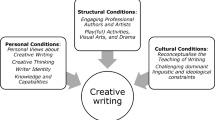Abstract
This study describes the thinking strategies and epistemological stances of two Bible experts, who applied a literary and historical interpretive approach, respectively. A thinking-aloud protocols methodology was used as the two scholars read the same biblical story and verbalized their thoughts. The findings reveal intricate relationships between thinking strategies and interpretive approaches. The two scholars use similar thinking strategies, yet apply them within distinct epistemological stances and reading objectives. Both apply close reading; recall commentaries; syntactic and grammatical analysis. Both connect the story with other biblical texts. However, their reading goals differ. One applies strategies that deconstruct the biblical story to different sources and restore the Urtext. The other applies a reading approach that conceives the text as a unified literary work. He constructs possible meanings and messages from the story using literary criticism tools, relating to literary genres, and actualizing the ancient text. I discuss how these findings contribute to the literature about Bible scholarship and religious education and its pedagogical implications.
Similar content being viewed by others
References
Barton, J. (1998). The Cambridge companion to biblical interpretation (pp. 9–20). Cambridge University Press.
Baumfield, V., & Cush, D. (2013). Religious education at the crossroads (again): The search for a subject identity? British Journal of Religious Education, 35, 231–235.
Boxall, I., & Gregory, B. C. (2022). The new Cambridge companion to biblical interpretation (1st ed., pp. 1–11). Cambridge University Press.
Docherty, S. (2018). A new dialogue between biblical scholarship and religious education. British Journal of Religious Education, 40(3), 298–307.
Ericsson, K. A., & Simon, H. A. (1998). How to study thinking in everyday life: Contrasting think-aloud protocols with descriptions and explanations of thinking. Mind Culture and Activity, 5(3), 178–186.
Gottlieb, E., & Wineburg, S. (2012). Between veritas and communitas: Epistemic switching in the reading of academic and sacred history. Journal of the Learning Sciences, 21(1), 84–129.
Gunn, D. M., McKenzie, S. L., & Haynes, S. R. (1993). To each its own meaning: An introduction to biblical criticisms and their application (pp. 171–195). Westminster John Knox Press.
Hassenfeld, Z. R. (2016). Reading sacred texts in the classroom: The alignment between students and their teacher’s interpretive stances when reading the Hebrew Bible. Journal of Jewish Education, 82(1), 81–107.
Haynes, S. R., & McKenzie, S. L. (1999). To each its own meaning: An introduction to biblical criticisms and their application. Westminster John Knox Press.
Huth, K. (2021). Using the pedagogy of thinking skills in christian studies lessons in primary school years 4–6: The teacher’s perspective. Journal of Religious Education, 69(1), 145–160.
Israeli Ministry of Education. (2019). Tanakh Curriculum for Mamlchti Education System. Israeli Ministry of Education.
Jasper, D. (1998). Literary readings of the Bible. The Cambridge Companion to Biblical Interpretation, 1, 21–34.
Kugel, J. L. (2007). How to read the Bible: A guide to scripture, then and now. Simon and Schuster.
Kurtz, P. M., & Historical, A. (2022). Critical retrospective on historical criticism. The new Cambridge companion to biblical interpretation (1st ed., pp. 15–36). Cambridge University Press.
Levine, S., & Horton, W. (2015). Helping high school students read like experts: Affective evaluation, salience, and literary interpretation. Cognition and Instruction, 33(2), 125–153.
Lozada, J. R. (2022). The new Cambridge companion to biblical interpretation (1st ed.). Cambridge University Press.
Peskin, J. (1998). Constructing meaning when reading poetry: An expert-novice study. Cognition and Instruction, 16(3), 235–263.
Peskin, J., & Ellenbogen, B. (2019). Cognitive processes while writing poetry: An expert-novice study. Cognition and Instruction, 37(2), 232–251.
Rackley, E. D. (2022). A comparative scripture-reading analysis of latter-day saint experts and novices. International Journal of Christianity & Education, 26(1), 32–49.
Reisman, A. (2012). Reading like a historian: A document-based history curriculum intervention in urban high schools. Cognition and Instruction, 30(1), 86–112.
Schwab, J. J. (1982). Science, curriculum, and liberal education: Selected essays. University of Chicago Press.
Shanahan, T., & Shanahan, C. (2012). What is disciplinary literacy and why does it matter? Topics in Language Disorders, 32(1), 7–18.
Shulman, L. S. (2008). Pedagogies of interpretation, argumentation, and formation: From understanding to identity in jewish education. Journal of Jewish Education, 74(s1), 5–15.
Smith, S. T. J. (2022). Historical criticism: Methods. In I. Boxall & B. C. Gregory (Eds.), The new Cambridge companion to biblical interpretation (1st ed., pp. 37–54). Cambridge University Press.
Tsemach, E., & Zohar, A. (2023). “The king will be corrupt too!” Teaching thinking in bible studies. Journal of Curriculum Studies, 55(1), 63–81.
The Hebrew Univeristy of Jerusalem (2023). Yearbook of Bible studies. https://bible.huji.ac.il/programs/BA.
Unstad, L., & Fjørtoft, H. (2021). Disciplinary literacy in religious education: The role and relevance of reading. British Journal of Religious Education, 43(4), 434–442.
Vermeer, P. (2012). Meta-concepts, thinking skills and religious education. British Journal of Religious Education, 34(3), 333–347.
Viviano, P. A. (1999). Source Criticism. In S. R. Haynes & S. L. McKenzie (Eds.), To each its own meaning: An introduction to biblical criticisms and their application. Westminster John Knox Press.
Wineburg, S. S. (1991). On the reading of historical texts: Notes on the breach between school and academy. American Educational Research Journal, 28(3), 495–519.
Funding
The author did not receive support from any organization for the submitted work.
Author information
Authors and Affiliations
Corresponding author
Ethics declarations
Conflict of interest
The author has no relevant financial or non-financial interests to disclose.
Additional information
Publisher’s Note
Springer Nature remains neutral with regard to jurisdictional claims in published maps and institutional affiliations.
Rights and permissions
Springer Nature or its licensor (e.g. a society or other partner) holds exclusive rights to this article under a publishing agreement with the author(s) or other rightsholder(s); author self-archiving of the accepted manuscript version of this article is solely governed by the terms of such publishing agreement and applicable law.
About this article
Cite this article
Tsemach, E. How do experts read the Bible? Descriptions of literary and historical approaches to biblical interpretation using thinking-aloud protocols. j. relig. educ. 72, 1–17 (2024). https://doi.org/10.1007/s40839-024-00222-7
Accepted:
Published:
Issue Date:
DOI: https://doi.org/10.1007/s40839-024-00222-7



